Digital Poster
Hyperpolarization (129 Xe
Joint Annual Meeting ISMRM-ESMRMB & ISMRT 31st Annual Meeting • 07-12 May 2022 • London, UK

| Computer # | ||||
|---|---|---|---|---|
1167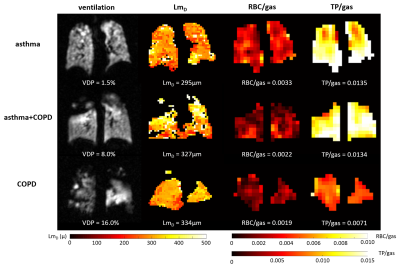 |
72 | 129Xe MRI patterns of lung function in patients with asthma and/or COPD in the NOVELTY study
Helen Marshall1, Laurie J Smith1, Alberto Biancardi1, Guilhem J Collier1, Ho-Fung Chan1, Paul JC Hughes1, Martin L Brook1, Joshua Astley1, Ryan Munro1, Smitha Rajaram1, Andrew J Swift1, David Capener1, Jody Bray1, Ayla K Hussain1, James Ball1, Olly Rodgers1, Demi Jakymelen1, Ian Smith1, Bilal A Tahir1, Madhwesha Rao1,
Graham Norquay1, Nick D Weatherley1, Leanne Armstrong1, Latife Hardaker2, Titti Fihn-Wikander3, François-Xavier Blé4, Rod Hughes5, and Jim M Wild1
1Department of Infection, Immunity and Cardiovascular Disease, University of Sheffield, Sheffield, United Kingdom, 2Priory Medical Group, York, United Kingdom, 3Evidence Delivery, BioPharmaceuticals Medical, Biopharmaceuticals Business Unit, AstraZeneca, Gothenburg, Sweden, 4Translational Science and Experimental Medicine, Research and Early Development, Respiratory & Immunology, Biopharmaceuticals R&D, AstraZeneca, Cambridge, United Kingdom, 5Clinical Development, Research and Early Development, Respiratory & Immunology, AstraZeneca, Cambridge, United Kingdom
There is a need for biomarkers to guide appropriate treatment in patients with clinical features of both asthma and COPD. A broadly-defined population of 164 patients with asthma and/or COPD taking part in the NOVELTY study were recruited from primary care and scanned with 129Xe MRI (ventilation, acinar microstructure and gas exchange measurements). 129Xe MRI global and regional metrics showed significant differences between patients with asthma, asthma+COPD and COPD. 129Xe MRI metrics remained sensitive to diagnosis sub-groups when only patients with normal pulmonary function tests were considered.
|
||
1168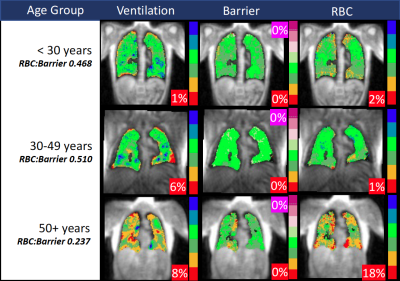 |
73 | Hyperpolarized 129Xe MRI and spectroscopy in healthy control subjects reveals age-related changes in measurements of pulmonary gas exchange
David Mummy1, Aparna Swaminathan2, Elianna Bier3, Kevin Yarnall4, Aryil Bechtel5, Junlan Lu6, Suphachart Leewiwatwong6, Sakib Kabir1, Jennifer Korzekwinski1, and Bastiaan Driehuys1,3,6
1Radiology, Duke University, Durham, NC, United States, 2Medicine, Duke University, Durham, NC, United States, 3Biomedical Engineering, Duke University, Durham, NC, United States, 4Mechanical Engineering, Duke University, Durham, NC, United States, 5Physics, Duke University, Durham, NC, United States, 6Medical Physics, Duke University, Durham, NC, United States
Age-related changes in 129Xe gas exchange MRI and spectroscopy are not well understood. We assessed a suite of common 129Xe-derived measures of gas exchange function in a population of healthy control subjects age 19-87. Increased age was associated with reduced red blood cell (RBC) to barrier ratio and with greater levels of ventilation defects and RBC transfer defects. These effects must be accounted for when evaluating 129Xe-derived metrics as markers of disease in individual patients. Notably, high barrier uptake remained largely minimal across age groups, and does not appear to be a feature of healthy aging.
|
||
1169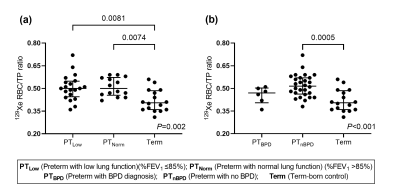 |
74 | Dissolved 129Xe spectroscopy in the lungs of preterm-born children
Ho-Fung Chan1, Guilhem J Collier1, Laurie J Smith1, Alberto M Biancardi1, Jody Bray1, Helen Marshall1, Paul J.C Hughes1, Madhwesha Rao1, Graham Norquay1, Andrew J Swift1, Kylie Hart2,3, Michael Cousins2,3, Sailesh Kotecha2,3, and Jim M Wild1
1Infection, Immunity and Cardiovascular Disease, University of Sheffield, Sheffield, United Kingdom, 2Child Health, Cardiff University School of Medicine, Cardiff, United Kingdom, 3Neonatal Unit, Cardiff and Vale University Health Board, Cardiff, United Kingdom
Ventilation defects and increased alveolar heterogeneity have been observed previously with 129Xe MRI in preterm-born children. We hypothesised that reduced gas exchange in preterm-born children could be measured with dissolved 129Xe whole lung spectroscopy. The ratio of red blood cells (RBC) to tissue/plasma (TP) signals (RBC/TP) was significantly elevated in the lungs of 34 preterm-born children compared with 16 term-born children. This trend was unexpected and we hypothesise that in preterm-born children a reduced number of alveolar septa due to birth at an early stage of lung development can lead to decreased TP signal and thus increased RBC/TP ratio.
|
||
1170 |
75 | 129Xe MRI Binning Analysis using Reference Values: Age-dependent Changes in Gas-Exchange MRI
Matthew Willmering1, Joseph Plummer1,2, Laura Walkup1,2,3,4, Zackary Cleveland1,2,3,4, and Jason Woods1,3,4,5
1Pulmonary Medicine, Cincinnati Children's Hospital Medical Center, Cincinnati, OH, United States, 2Biomedical Engineering, University of Cincinnati, Cincinnati, OH, United States, 3Radiology, Cincinnati Children's Hospital Medical Center, Cincinnati, OH, United States, 4Pediatrics, University of Cincinnati Medical Center, Cincinnati, OH, United States, 5Physics, University of Cincinnati, Cincinnati, OH, United States Previous 129Xe-MRI binning analysis techniques assumed normal distributions or relied on a Box-Cox transformation. Adapting these binning methods to account for known covariates of lung function and structure, such as age and height, was not straightforward. To account for these limitations, a new binning method is proposed here that uses the same modeling techniques used to increase sensitivity and specificity in spirometry and diffusing capacity for carbon monoxide (DLCO). By accounting for MRI image distribution shapes and covariates, healthy representative data distributions are better modelled and can permit increased sensitivity and specificity, particularly for early cardiopulmonary disease progression. |
||
1171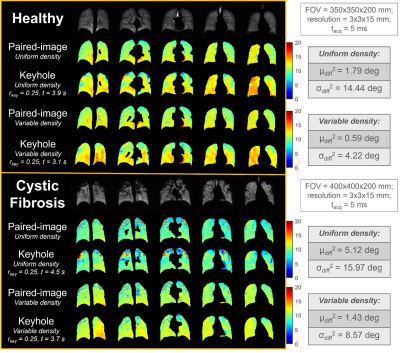 |
76 | Flip-angle map calculation via keyhole reconstruction in uniform and variable-density 2D-spiral hyperpolarized 129Xe MRI
Joseph W Plummer1,2, Abdullah S Bdaiwi1,2, Mariah L Costa1,2, Matthew M Willmering1, Zackary I Cleveland1,2,3, and Laura L Walkup1,2,3,4
1Center for Pulmonary Imaging Research, Department of Pulmonary Medicine, Cincinnati Children's Hospital Medical Center, Cincinnati, OH, United States, 2Biomedical Engineering, University of Cincinnati, Cincinnati, OH, United States, 3Department of Radiology, Cincinnati Children's Hospital Medical Center, Cincinnati, OH, United States, 4Department of Pediatrics, Cincinnati Children's Hospital Medical Center, Cincinnati, OH, United States
Hyperpolarized 129Xe-MRI is prone to B1-inhomogeneity-induced signal artifacts, that often obscure pulmonary abnormalities. B1-inhomeogeneity can be corrected by calculating a flip-angle map and rescaling the images. Current methods to acquire a flip-angle map in 2D-spiral sequences require two-successive images to be collected in a single breath-hold, doubling scan duration. We demonstrate that flip-angle maps can be calculated from a single image acquisition using keyhole reconstruction. Furthermore, analytical methods can be used to minimize the amount of required oversampling. This approach enables accurate B1-artifact correction, with minimal impact to scan-duration, making it especially useful for short breath-hold studies.
|
||
1172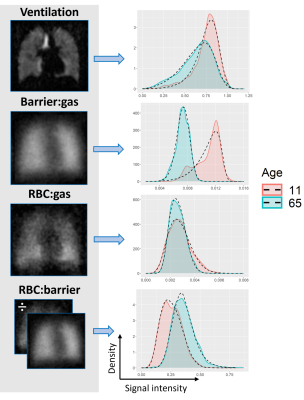 |
77 | Assessing the Age Dependence of 129Xe Gas-exchange MRI for Individual Healthy Subjects
Joseph Plummer1,2, Matthew Willmering1, Laura Walkup1,2,3,4, Zackary Cleveland1,2,3,4, and Jason Woods1,3,4,5
1Pulmonary Medicine, Cincinnati Children's Hospital Medical Center, Cincinnati, OH, United States, 2Biomedical Engineering, University of Cincinnati, Cincinnati, OH, United States, 3Radiology, Cincinnati Children's Hospital Medical Center, Cincinnati, OH, United States, 4Pediatrics, University of Cincinnati Medical Center, Cincinnati, OH, United States, 5Physics, University of Cincinnati, Cincinnati, OH, United States 129Xe-MRI can quantify abnormal gas-exchange by defining thresholds derived from voxel-level gas-exchange distributions in healthy subjects. Previous studies assumed a constant healthy distribution independent of age. By fitting to Box-Cox Power Exponential distributions, normal distributions cannot be assumed, and the distributions vary significantly with age. The effect size of age (5-69 years) on healthy ventilation, barrier-uptake, and red-blood cell to barrier (ratio) signal distributions were 14 to 57%. Thus, age and distribution shape should be considered when defining reference distributions for gas-exchange metrics. By accounting for age-dependent variations, the reference distributions abnormal thresholds could be narrowed. |
||
1173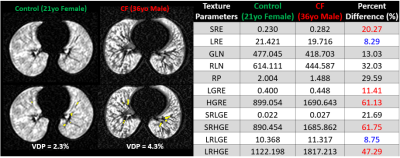 |
78 | Texture Analysis as an Adjunct to Hyperpolarized 129Xe Ventilation Defect Percentage for Quantifying Cystic Fibrosis Lung Disease Severity
Dustin J. Basler1, Abdullah S. Bdaiwi1,2, Matthew M. Willmering1, Laura L. Walkup1,2,3,4, Zackary I. Cleveland1,2,3,4, and Jason C. Woods1,3,4
1Center for Pulmonary Imaging Research, Cincinnati Children's Hospital Medical Center, Cincinnati, OH, United States, 2Department of Biomedical Engineering, University of Cincinnati, Cincinnati, OH, United States, 3Department of Radiology, Cincinnati Children's Hospital Medical Center, Cincinnati, OH, United States, 4Department of Pediatrics, University of Cincinnati, Cincinnati, OH, United States
MRI of hyperpolarized 129Xe has been shown to be a robust, non-invasive biomarker to assess pulmonary disease pathophysiology. Static spin-density maps (ventilation images) are commonly analyzed using the ventilation defect percentage (VDP) to quantify the degree of airway obstruction in diseases including asthma, chronic obstructive pulmonary disease, and cystic fibrosis. However, VDP reduces the intrinsic 3D-spatial richness of ventilation images to a global measure, suppressing underlying spatial correlations. In this work, a gray-level run-length matrix (GLRLM) analysis is assessed as an adjunct to VDP analysis for quantifying obstruction in Cystic Fibrosis (CF) lung disease, relative to a healthy control cohort.
|
||
1174 |
79 | Age and lung volume dependence of dissolved xenon-129 imaging parameters
Guilhem J. Collier1, Ho-Fung Chan1, Neil J. Stewart1, Graham Norquay1, Laurie J. Smith1, Madhwesha Rao1, Helen Marshall1, Rolf F. Schulte2, and Jim M. Wild1
1POLARIS, University of Sheffield, Sheffield, United Kingdom, 2GE Healthcare, Munich, Germany
This work investigates the correlation between age and pulmonary gas transfer measurements assessed with dissolved xenon-129 MRI in 26 healthy volunteers with an age range of 23 to 68yrs. Dependence on lung inflation is also investigated by performing imaging at total lung capacity. Results show significant negative correlations of xenon tissue uptake and blood transfer and suggest that an age-correction should be performed when reporting results. Imaging at total lung capacity also confirms a significant decrease in xenon gas transfer when compared to imaging during standard inspiratory breath-hold.
|
||
1175 |
80 | Dynamic Free-Breathing Ventilation and Gas Exchange with Hyperpolarized Xenon-129
Faraz Amzajerdian1, Hooman Hamedani1, Ryan Baron1, Yi Xin1, Tahmina Achekzai1, Luis Loza1, Mostafa Ismail1, Ian Duncan1, Stephen Kadlecek1, Kai Ruppert1, and Rahim Rizi1
1University of Pennsylvania, Philadelphia, PA, United States
Hyperpolarized xenon-129 (HXe) imaging is capable of quantifying lung function through measurements of ventilation and gas exchange. However, traditional HXe approaches rely on long breath-holds for imaging, which may not be representative of steady-state behavior and are limited by the volume of gas that can be delivered. In this work, we imaged gas- and dissolved-phase xenon continuously over approximately 50 breaths and retrospectively binned the images, generating dynamic maps encompassing the entire respiratory cycle.
|
||
1176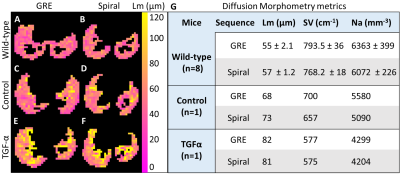 |
81 | Hyperpolarized 129Xe Diffusion MRI and Diffusion Morphometry in Mice using 2D Spiral
Mariah L. Costa1,2, Brice J. Albert1, Abdullah S. Bdaiwi1,2, Harshavardhana H. Ediga3,4, Satish K. Madala3,5, Peter J. Niedbalski1,6, and Zackary I. Cleveland1,2,3,5,7
1Center for Pulmonary Imaging Research, Cincinnati Children's Hospital Medical Center, Cincinnati, OH, United States, 2Biomedical Engineering, University of Cincinnati, Cincinnati, OH, United States, 3Pulmonary Medicine, Cincinnati Children's Hospital Medical Center, Cincinnati, OH, United States, 4Biochemistry, National Institute of Nutrition, Telangana, India, 5Pediatrics, University of Cincinnati, Cincinnati, OH, United States, 6Pulmonary and Critical Care, University of Kansas Medical Center, Kansas City, KS, United States, 7Imaging Research Center, Cincinnati Children's Hospital Medical Center, Cincinnati, OH, United States Hyperpolarized (HP) 129Xe diffusion imaging, including the apparent diffusion coefficient (ADC) and more sophisticated diffusion morphometry, can assess microstructural dimensions of the acinar airspace. In diseases characterized by alveolar destruction (eg, emphysema), these parameters strongly indicate disease severity. Here, a time-efficient, 2D-spiral diffusion sequence was developed and compared to a conventional GRE-based sequence in a free-diffusion phantom, wild-type mice, a and a transgenic mouse model of lung fibrosis that develops emphysema as a comorbidity. Both sequences provided comparable SNR, ADC values, and morphometry metrics, indicating spiral sequences can assess airspace size in mice, while making efficient use of HP magnetization. |
||
1177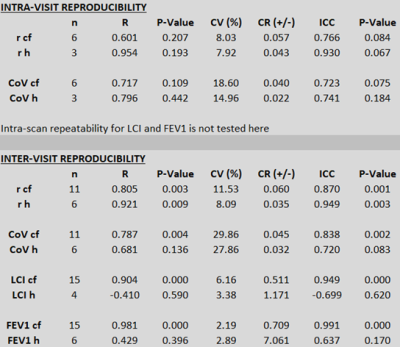 |
82 | Intra-Visit and Inter-Visit Repeatability of 129Xe Multiple-Breath Washout MRI in Children with Stable Cystic Fibrosis Lung Disease
Faiyza Shoaib Alam1,2, Brandon Zanette2, Sharon Braganza2, Daniel Li2, Felix Ratjen2,3, and Giles Santyr1,2
1Medical Biophysics, University of Toronto, Toronto, ON, Canada, 2Translational Medicine, Hospital for Sick Children, Toronto, ON, Canada, 3Division of Respirology, Hospital for Sick Children, Toronto, ON, Canada
Hyperpolarized 129Xe MRI (Xe-MRI) yielding VDP has shown advantages over conventional PFT’s for assessing paediatric CF lung disease but is only a static “snapshot” of a dynamic process. Xe-MRI can be conducted in a MBW fashion to yield temporal/spatial heterogeneity of the gas during respiration, resulting in regional maps of fractional ventilation (r), a measure of percent gas clearance per breath. This work assessed the within-visit and inter-visit repeatability of MBW Xe-MRI between baseline and one-month follow-up in paediatric subjects with stable CF and found strong intra- and inter-visit repeatability. Significant correlations between MBW Xe-MRI and LCI were also found.
|
||
1178 |
83 | Ventilation Defect Synthesis in Hyperpolarized 129Xe Ventilation MRI to Accelerate Training of Segmentation Models
Suphachart Leewiwatwong1, Junlan Lu2, Jesse Zhang3, David Mummy4, Isabelle Dummer4,5, Kevin Yarnall6, Ziyi Wang1, and Bastiaan Driehuys1,2,4
1Biomedical Engineering, Duke University, Durham, NC, United States, 2Medical Physics, Duke University, Durham, NC, United States, 3Mathematics, Duke University, Durham, NC, United States, 4Radiology, Duke University, Durham, NC, United States, 5Bioengineering, McGill University, Montréal, QC, Canada, 6Mechanical Engineering and Materials Science, Duke University, Durham, NC, United States
Quantification of 129Xe MRI relies on accurate segmentation of the thoracic cavity. This segmentation could potentially be performed directly on the 129Xe ventilation image using an automated convolutional neural network, but this task is challenging, especially in cases where peripheral ventilation defects obscure the lung boundary. Currently, overcoming this obstacle requires large, diverse training datasets created by time-consuming manual segmentation. Here, we demonstrate the use of a generative Pix2Pix model to synthesize both 129Xe images with defects, and corresponding segmentation masks. We then test the effects of this additional training data on the performance of an existing U-net segmentation algorithm.
|
||
The International Society for Magnetic Resonance in Medicine is accredited by the Accreditation Council for Continuing Medical Education to provide continuing medical education for physicians.